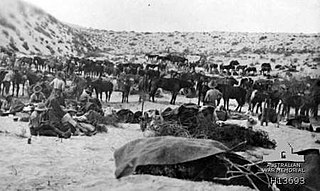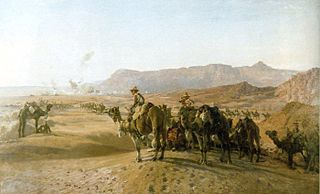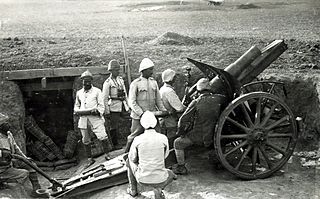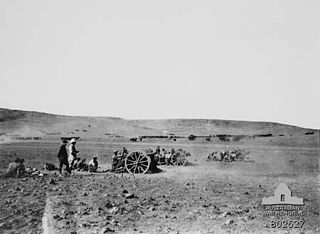
The Battle of Romani was the last ground attack of the Central Powers on the Suez Canal at the beginning of the Sinai and Palestine campaign during the First World War. The battle was fought between 3 and 5 August 1916 near the Egyptian town of Romani and the site of ancient Pelusium on the Sinai Peninsula, 23 mi (37 km) east of the Suez Canal. This victory by the 52nd (Lowland) Division and the Anzac Mounted Division of the Egyptian Expeditionary Force (EEF) over a joint Ottoman and German force, which had marched across the Sinai, marked the end of the Defence of the Suez Canal campaign, also known as the Offensive zur Eroberung des Suezkanals and the İkinci Kanal Harekâtı, which had begun on 26 January 1915.

The Battle of Magdhaba took place on 23 December 1916 during the Defence of Egypt section of the Sinai and Palestine Campaign in the First World War. The attack by the Anzac Mounted Division took place against an entrenched Ottoman Army garrison to the south and east of Bir Lahfan in the Sinai desert, some 18–25 miles (29–40 km) inland from the Mediterranean coast. This Egyptian Expeditionary Force (EEF) victory against the Ottoman Empire garrison also secured the town of El Arish after the Ottoman garrison withdrew.

The Battle of Rafa, also known as the Action of Rafah, fought on 9 January 1917, was the third and final battle to complete the recapture of the Sinai Peninsula by British forces during the Sinai and Palestine campaign of the First World War. The Desert Column of the Egyptian Expeditionary Force (EEF) attacked an entrenched Ottoman Army garrison at El Magruntein to the south of Rafah, close to the frontier between the Sultanate of Egypt and the Ottoman Empire, to the north and east of Sheikh Zowaiid. The attack marked the beginning of fighting in the Ottoman territory of Palestine.

The First Battle of Gaza was fought on 26 March 1917 during the first attempt by the Egyptian Expeditionary Force (EEF), which was a British Empire military formation, formed on 10 March 1916 under the command of General Archibald Murray from the Mediterranean Expeditionary Force and the Force in Egypt (1914–15), at the beginning of the Sinai and Palestine Campaign of the First World War. Fighting took place in and around the town of Gaza on the Mediterranean coast when infantry and mounted infantry from the Desert Column, a component of the Eastern Force, attacked the town. Late in the afternoon, on the verge of capturing Gaza, the Desert Column was withdrawn due to concerns about the approaching darkness and large Ottoman reinforcements. This British defeat was followed a few weeks later by the even more emphatic defeat of the Eastern Force at the Second Battle of Gaza in April 1917.

The Battle of Beersheba was fought on 31 October 1917, when the British Empire's Egyptian Expeditionary Force (EEF) attacked and captured the Ottoman Empire's Yildirim Army Group garrison at Beersheba, beginning the Southern Palestine Offensive of the Sinai and Palestine campaign of World War I.

The Second Battle of Gaza was fought on 17–19 April 1917, following the defeat of the Egyptian Expeditionary Force (EEF) at the First Battle of Gaza in March, during the Sinai and Palestine Campaign of the First World War. Gaza was defended by the strongly entrenched Ottoman Army garrison, which had been reinforced after the first battle by substantial forces. They manned the town's defences and a line of strong redoubts which extended eastwards along the road from Gaza to Beersheba. The defenders were attacked by the Eastern Force's three infantry divisions, supported by two mounted divisions, but the strength of the defenders, their entrenchments & supporting artillery decimated the attackers.
The Third Battle of Gaza was fought on the night of 1–2 November 1917 between British and Ottoman forces during the Sinai and Palestine Campaign of World War I and came after the British Egyptian Expeditionary Force (EEF) victory at the Battle of Beersheba had ended the Stalemate in Southern Palestine. The fighting occurred at the beginning of the Southern Palestine Offensive, and, together with attacks on Hareira and Sheria on 6–7 November and the continuing Battle of Tel el Khuweilfe, which had been launched by General Edmund Allenby on 1 November, it eventually broke the Gaza-to-Beersheba line defended by the Yildirim Army Group. Despite having held this line since March 1917, the Ottoman Army was forced to evacuate Gaza and Tel el Khuweilfe during the night of 6–7 November. Only Sheria held out for most of 7 November before it too was captured.

The Sinai and Palestine campaign was part of the Middle Eastern theatre of World War I, taking place between January 1915 and October 1918. The British Empire, the French Third Republic, and the Kingdom of Italy fought alongside the Arab Revolt in opposition to the Ottoman Empire, the German Empire, and the Austro-Hungarian Empire. It started with an Ottoman attempt at raiding the Suez Canal in 1915 and ended with the Armistice of Mudros in 1918, leading to the cession of Ottoman Syria.

The Senussi campaign took place in North Africa from November 1915 to February 1917, during the First World War. The campaign was fought by the Kingdom of Italy and the British Empire against the Senussi, a religious order of Arabic nomads in Libya and Egypt. The Senussi were courted by the Ottoman Empire and the German Empire. Recognising French and Italian threats, the Ottoman Sultan, Abdul Hamid II, had twice sent his aide-de-camp Azmzade Sadik El Mueyyed to meet Sheikh Muhammed El Mehdi El Senussi to cultivate positive relations and counter the west European scramble for Africa. In the summer of 1915, the Ottomans persuaded the Grand Senussi, Ahmed Sharif as-Senussi, to declare jihad, attack British-occupied Egypt from the west and encourage insurrection in Egypt, to divert British forces.

The Battle of el Buqqar Ridge took place on 27 October 1917, when one infantry regiment and cavalry troops of the Yildirim Army Group, attacked the 8th Mounted Brigade of the Egyptian Expeditionary Force (EEF) in the last days of the stalemate in Southern Palestine during the Sinai and Palestine campaign of World War I.

The Western Frontier Force was raised from British Empire troops during the Senussi campaign from November 1915 to February 1917, under the command of the Egyptian Expeditionary Force (EEF). Orders for the formation of the force were issued on 20 November 1915, under Major-General Alexander Wallace, C.B. The force concentrated at Mersa Matruh on the coast and began operations against the Senussi in late 1915.

The Desert Column was a First World War British Empire army corps which operated in the Sinai and Palestine Campaign from 22 December 1916. The Column was commanded by Lieutenant General Philip W. Chetwode and formed part of Eastern Force. When Chetwode took command of Eastern Force after the Second Battle of Gaza, Harry Chauvel took command and oversaw the expansion of the column to three divisions.

The Raid on the Beersheba to Hafir el Auja railway took place on 23 May 1917 after the Second Battle of Gaza and before the Battle of Beersheba during the Stalemate in Southern Palestine in the Sinai and Palestine Campaign of World War I.

The Raid on Nekhl was the second of three battles by British forces to recapture the Sinai Peninsula during the Sinai and Palestine Campaign of World War I. Egyptian Expeditionary Force (EEF) mounted forces travelled into the centre of the Sinai Peninsula to attack and push the last Ottoman Army garrisons back into Palestine.

The Stalemate in Southern Palestine was a six-month standoff between the British Egyptian Expeditionary Force (EEF) and the Ottoman Army in World War I. The two hostile forces faced each other along the Gaza to Beersheba line during the Sinai and Palestine Campaign, with neither side able to force its opponent to withdraw. The stalemate began in April 1917 with the defeat of the EEF by the Ottoman Army at the Second Battle of Gaza and lasted until the EEF offensive began with the Battle of Beersheba on 31 October 1917.
The Southern Palestine offensive, began on 31 October 1917, with the Battle of Beersheba, when the British Empire's Egyptian Expeditionary Force (EEF) under the Command of Field Marshall Edmund Allenby attacked Ottoman Empire forces at the Palestinian town of Beersheba during the Sinai and Palestine Campaign, of World War I. After the capture of Beersheba, by the EEF, the Gaza to Beersheba line became increasingly weakened and, seven days later, the EEF successfully forced the Ottoman Turkish Empire's Seventh and Eighth Armies to withdraw. During the following seven days of pursuit, the Turkish forces were pushed back to Jaffa. There followed three weeks of hard fighting in the Judean Hills before Jerusalem was captured on 9 December 1917. During five and a half weeks of almost continuous offensive operations, the EEF captured 47.5 miles (76.4 km) of territory.

The Battle of Hareira and Sheria was fought on 6–7 November 1917 when the Egyptian Expeditionary Force attacked and captured the Yildirim Army Group's defensive systems protecting Hareira and Sheria in the centre of the Gaza to Beersheba line, during the Southern Palestine Offensive of the Sinai and Palestine Campaign in World War I.

The Battle of Tel el Khuweilfe, part of the Southern Palestine Offensive, began on 1 November 1917, the day after the Egyptian Expeditionary Force (EEF) victory at the Battle of Beersheba during the Sinai and Palestine Campaign of World War I. After the Stalemate in Southern Palestine a series of coordinated attacks were launched by British Empire units on the Ottoman Empire's German commanded Yildirim Army Group's front line, which stretched from Gaza inland to Beersheba. During the fight for the town, the road from Beersheba to Jerusalem via Hebron, was cut just north of the town in the southern spur of the Judean Hills. Here Ottoman units strongly defended the road and the Seventh Army headquarters at Hebron.
The Capture of Wadi el Hesi and the associated Sausage Ridge, began during the evening of 7 November 1917, was fiercely fought for during 8 November and not cleared until the early hours of 9 November, at the beginning of the pursuit phase of the Southern Palestine Offensive in the Sinai and Palestine Campaign during World War I. The advancing British Empire units of the Egyptian Expeditionary Force (EEF) were held by rearguard units of the withdrawing Ottoman Empire units of the Yildirim Army Group, holding a strategically strong position to the north of Gaza.

The Raid on Bir el Hassana (Hasna) occurred in the Sinai Peninsula in February 1917, during World War I. It was a minor action between an augmented battalion of the Imperial Camel Corps on the one side and a score of Turkish troops plus some armed Bedouin on the other. The raid occasioned the first aeromedical evacuation in the British Army.



















